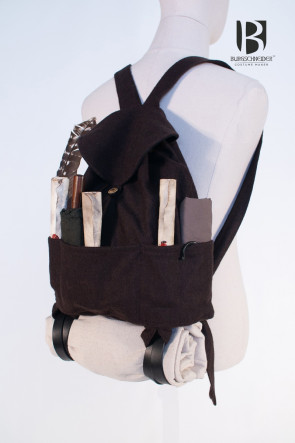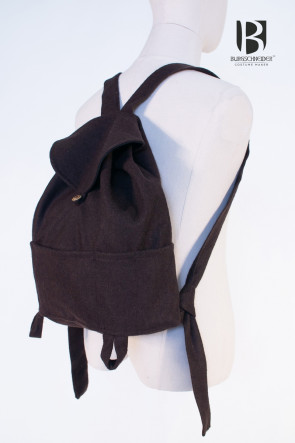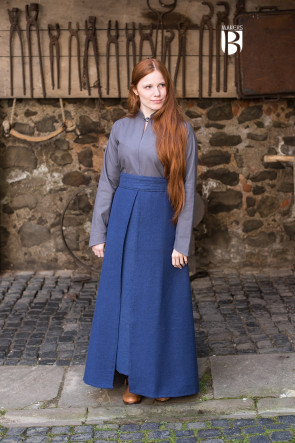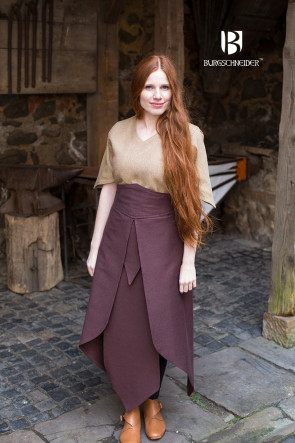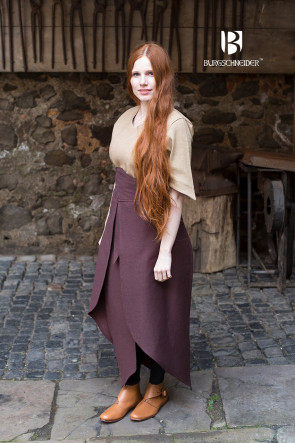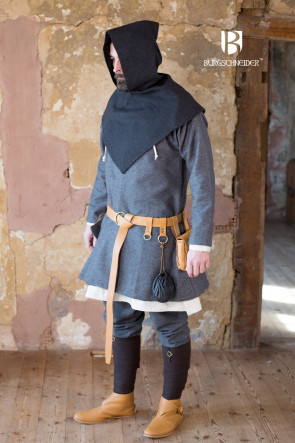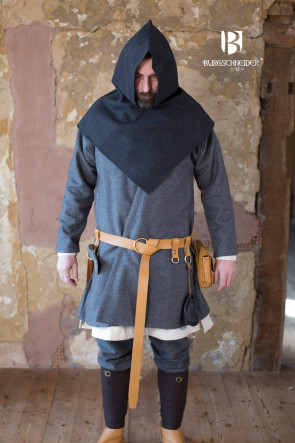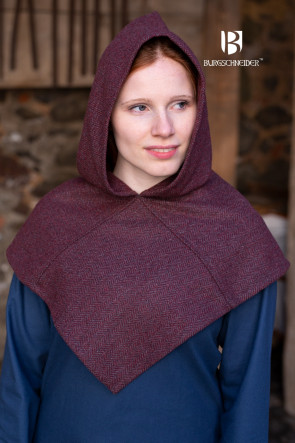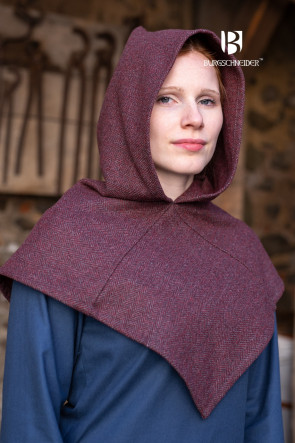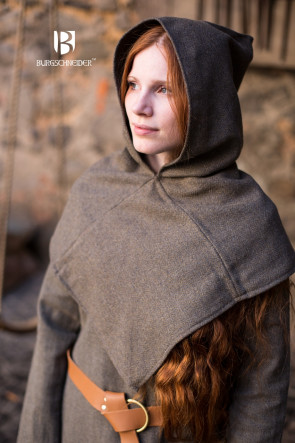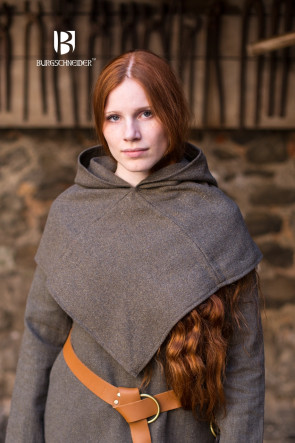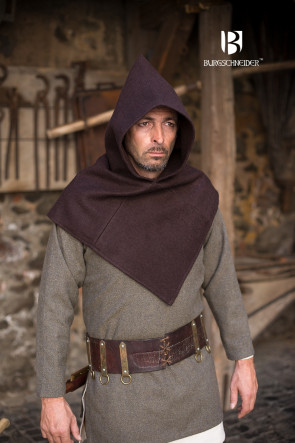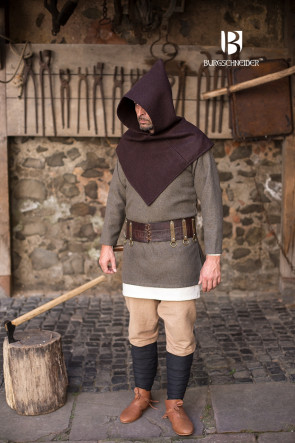LARP costume
Clothing plays a significant role in successfully creating the ambience of any LARP event. It is therefore particularly important that the costumes of the attendees suit the setting of the event.
In LARPing, we usually don’t speak of costumes but of garments, to distinguish the clothing from disguises such as those worn at Carnival or on Halloween. While a costume for a party or Halloween is designed primarily to amuse, LARP garments belong—in a classic men’s and women’s fashion context—to a more upscale category, alongside suits and evening gowns. LARP garments are the clothes of the character whom you are bringing to life at a Live Action Role Play event—and that character can be as complex as one from a novel or a movie. These garments will be worn at various events over several years and have to withstand vigorous activity—such as showpiece fights—and harsh weather conditions.
LARP garments in the vicissitude of time
Thanks to an ever-growing LARP community, the quality of LARP garments has continuously improved. Whereas in the early days of the hobby, players used knitted sweaters to emulate chainmail and bed sheets as cloaks, today there is a wide range of affordable armor, tunics, cloaks, and dresses available; as a result, in LARPing mere party costumes lose acceptance and relevance. On the other hand, LARP garments can be used as a costume for Halloween or theme parties, where, thanks to the higher quality of materials and manufacturing, they tend to really stand out from the crowd.
Your LARP garments for a theme party
For party themes such as Vikings, elves, or anything medieval, you can of course come as you are in your usual LARP garments. Should you try your hand at crafting, however, you can certainly have at it. Be it a coffee bath, boot polish, or artificial blood to appropriately modify a dress to play a zombie maid, or woven laces and embroidery to depict a nobleman—the LARPing community provides creative resources for all kinds of ideas.
-
Rucksack Robin - Brown
Rucksack Robin
Wool felt with cotton lining
- Genre: Fantastic
- Sizes: unisize
- Product Details:
- Adjustable straps.
- Functional loops for additional equipment.
- Patch pockets on the outside.
- Material: Kent Melton Wool felt made of 74% Wool, 15% Polyester, 7% Polyamide, 4% other natural fibers with lining 100% Cotton
- Decoration not included.
- The colours shown may differ from the actual colours depending on the monitor and resolution of your computer.
- Please note that cotton fabrics may shrink when washed!
€39.90 -
Rucksack Robin - Green
Rucksack Robin
Wool felt with cotton lining
- Genre: Fantastic
- Sizes: unisize
- Product Details:
- Adjustable straps.
- Functional loops for additional equipment.
- Patch pockets on the outside.
- Material: Kent Melton Wool felt made of 74% Wool, 15% Polyester, 7% Polyamide, 4% other natural fibers with lining 100% Cotton
- Decoration not included.
- The colours shown may differ from the actual colours depending on the monitor and resolution of your computer.
- Please note that cotton fabrics may shrink when washed!
€39.90 -
Skirt Mera - Blue
- Material: 100% Cotton
- Genre: Fictional
- Sizes: S/M - L/XL - XXL/XXXL
- Maker: Lena Krause
€45.90 -
Skirt Tharya - Blue
- Material: 100% Cotton
- Genre: Fictional
- Sizes: S/M - L/XL - XXL/XXXL
- Maker: Lena Krause
€39.90 -
Skirt Tharya - Brown
- Material: 100% Cotton
- Genre: Fictional
- Sizes: S/M - L/XL - XXL/XXXL
- Maker: Lena Krause
€39.90 -
Skjoldehamn Gugel Knud Herringbone - Black/Grey
The Skjoldehamn Cowl was discovered in a pagan grave from the first half of the 11th century. This is one of the first examples of the headgear "Gugel" itself.
Learn More
The hood has a basic square shape, characteristically the wide brim ends with a corner on the chest.
The grave find from Skjoldehamn raised many questions since its recovery in 1936 and still occupies today. According to current research, the dating of the pagan grave in the marshland is the first half of the 11th century. The hood of the gugel from Skjoldehamn has a simple square basic shape and a very wide brim which does not fall round but with a corner on the chest. This gugel is also a very early example of the type of headgear that became a ubiquitous garment in Europe during the Middle Ages.
In the course of research, attempts were made to assign the garment to a gender and cultural group. For this purpose, not only the DNA of the buried person was examined more closely but also the additional finds. The enclosed trousers determined the theory of the researchers that the person must have been male. DNA examination in 1999 showed no Y chromosome present in the bones which supported the theory that it had to be a woman instead. However, this methodology is considered outdated.
The question of culture points to Norway. This is assumed by ornamentation and morphological features which suggest that the buried person was a Sami tribal member. Further research is needed, as some key evidence for these hypotheses is still lacking. More modern DNA analysis and research into the history of the fashions of the various Sami groups will shed light on this.€34.90 -
Skjoldehamn Gugel Knud Herringbone - Burgundy/Grey
The Skjoldehamn Cowl was discovered in a pagan grave from the first half of the 11th century. This is one of the first examples of the headgear "Gugel" itself.
Learn More
The hood has a basic square shape, characteristically the wide brim ends with a corner on the chest.
The grave find from Skjoldehamn raised many questions since its recovery in 1936 and still occupies today. According to current research, the dating of the pagan grave in the marshland is the first half of the 11th century. The hood of the gugel from Skjoldehamn has a simple square basic shape and a very wide brim which does not fall round but with a corner on the chest. This gugel is also a very early example of the type of headgear that became a ubiquitous garment in Europe during the Middle Ages.
In the course of research, attempts were made to assign the garment to a gender and cultural group. For this purpose, not only the DNA of the buried person was examined more closely but also the additional finds. The enclosed trousers determined the theory of the researchers that the person must have been male. DNA examination in 1999 showed no Y chromosome present in the bones which supported the theory that it had to be a woman instead. However, this methodology is considered outdated.
The question of culture points to Norway. This is assumed by ornamentation and morphological features which suggest that the buried person was a Sami tribal member. Further research is needed, as some key evidence for these hypotheses is still lacking. More modern DNA analysis and research into the history of the fashions of the various Sami groups will shed light on this.€34.90 -
Skjoldehamn Gugel Knud Herringbone - Olive/Grey
The Skjoldehamn Cowl was discovered in a pagan grave from the first half of the 11th century. This is one of the first examples of the headgear "Gugel" itself.
Learn More
The hood has a basic square shape, characteristically the wide brim ends with a corner on the chest.
The grave find from Skjoldehamn raised many questions since its recovery in 1936 and still occupies today. According to current research, the dating of the pagan grave in the marshland is the first half of the 11th century. The hood of the gugel from Skjoldehamn has a simple square basic shape and a very wide brim which does not fall round but with a corner on the chest. This gugel is also a very early example of the type of headgear that became a ubiquitous garment in Europe during the Middle Ages.
In the course of research, attempts were made to assign the garment to a gender and cultural group. For this purpose, not only the DNA of the buried person was examined more closely but also the additional finds. The enclosed trousers determined the theory of the researchers that the person must have been male. DNA examination in 1999 showed no Y chromosome present in the bones which supported the theory that it had to be a woman instead. However, this methodology is considered outdated.
The question of culture points to Norway. This is assumed by ornamentation and morphological features which suggest that the buried person was a Sami tribal member. Further research is needed, as some key evidence for these hypotheses is still lacking. More modern DNA analysis and research into the history of the fashions of the various Sami groups will shed light on this.€34.90 -
Skjoldehamn Wool Cowl Bjorn - Autumn Green
The Skjoldehamn Cowl was discovered in a pagan grave from the first half of the 11th century. This is one of the first examples of the headgear "Gugel" itself.
The hood has a basic square shape, characteristically the wide brim ends with a corner on the chest.
The grave find from Skjoldehamn raised many questions since its recovery in 1936 and still occupies today. According to current research, the dating of the pagan grave in the marshland is the first half of the 11th century. The hood of the gugel from Skjoldehamn has a simple square basic shape and a very wide brim, which does not fall round, but with a corner on the chest. This gugel is also a very early example of the type of headgear that became a ubiquitous garment in Europe during the Middle Ages.
In the course of research, attempts were made to assign the garment to a gender and cultural group. For this purpose, not only the DNA of the buried person was examined more closely, but also the additional finds. The enclosed trousers determined the theory of the researchers that the person must have been male. DNA examination in 1999 showed no Y chromosome present in the bones, which supported the theory that it had to be a woman instead. However, this methodology is considered outdated.
The question of culture points to Norway. This is assumed by ornamentation and morphological features, which suggest that the buried person was a Sami tribal member. Further research is needed, as some key evidence for these hypotheses is still lacking. More modern DNA analysis and research into the history of the fashions of the various Sami groups will shed light on this.
Learn More€29.90 -
Skjoldehamn Wool Cowl Bjorn - Brown
The Skjoldehamn Cowl was discovered in a pagan grave from the first half of the 11th century. This is one of the first examples of the headgear "Gugel" itself.
The hood has a basic square shape, characteristically the wide brim ends with a corner on the chest.
The grave find from Skjoldehamn raised many questions since its recovery in 1936 and still occupies today. According to current research, the dating of the pagan grave in the marshland is the first half of the 11th century. The hood of the gugel from Skjoldehamn has a simple square basic shape and a very wide brim, which does not fall round, but with a corner on the chest. This gugel is also a very early example of the type of headgear that became a ubiquitous garment in Europe during the Middle Ages.
In the course of research, attempts were made to assign the garment to a gender and cultural group. For this purpose, not only the DNA of the buried person was examined more closely, but also the additional finds. The enclosed trousers determined the theory of the researchers that the person must have been male. DNA examination in 1999 showed no Y chromosome present in the bones, which supported the theory that it had to be a woman instead. However, this methodology is considered outdated.
The question of culture points to Norway. This is assumed by ornamentation and morphological features, which suggest that the buried person was a Sami tribal member. Further research is needed, as some key evidence for these hypotheses is still lacking. More modern DNA analysis and research into the history of the fashions of the various Sami groups will shed light on this.
Learn More€29.90







